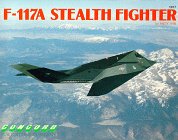The Lockheed F-117A was developed in response to an Air Force request for an aircraft capable of attacking high value targets without being detected by hostile radar systems. By the 1970s, special materials and techniques had become available to aircraft designers that would allow them to design an aircraft with radar-evading or “stealth” qualities. The result was the F-117A, the world’s first operational aircraft that fully incorporated radar-evading techniques.
The first F-117A flew on June 18, 1981 and the first F-117A unit, the 4450th Tactical Group, achieved initial operating capability in October 1983. The 4450th was renamed the 37th Tactical Fighter Wing in October 1989.
The F-117A was first used in combat during operation Just Cause on December 19, 1989 when two F-117As from the 37th TFW attacked military targets in Panama. The F-117A was again called into action during Operation Desert Shield/Desert Storm in 1990-91 when the 415th and the 416th squadrons of the 37th TFW moved to a base in Saudi Arabia. During Operation Desert Storm the F-117As flew 1,271 sorties, achieving an 80 percent mission success rate while suffering no losses or battle damage.
A total of 64 F-117As were built between 1981 and 1990, 5 for testing and 59 for operational use.
The F-117A was awarded the 1989 Collier Trophy, one of the most prized aeronautical awards in the world.
F-117A Nighthawk Performance
| Maximum Speed | High subsonic |
|---|---|
| Cruising Speed | 684 mph. |
| Range | Unlimited with aerial refueling |
| Service Ceiling | 45,000 ft. |
F-117A Nighthawk Specifications
| Country of Origin | USA. |
|---|---|
| Similar Aircraft | None. |
| Crew | One. |
| Role | Defense suppression, precision bombing against high-priority targets. |
| Armament | Up to 4,000 lbs. of bombs and missings in internal stores |
| Engines | Two General Electric F404-F1D2 engines of 10,600 lbs. thrust ea. |
| Span | 43 ft. 4 in. |
| Length | 65 ft. 11 in. |
| Height | 12 ft. 5 in. |
| Weight | 52,500 lbs. max. |
F-117A Night Hawk WEFT Description
| Wings | Low-mounted, swept-back, and tapered with square tips. |
|---|---|
| Engine(s) | Two turbofans mounted inside the body. Rectangular, overwing air intakes. Narrow slotted �”platypus�” exhausts. |
| Fuselage | Sharp, pointed nose. Pyramid and faceted appearance. Stepped-up cockpit. |
| Tail | Sharply swept-back and tapered, V-configured tail fins with square tips. No tail flats. |
Countries which Fly the F-117A Night Hawk
USA.
F-117A Night Hawk Manufacturer Web Site
Books on the F-117A Night Hawk

F-117A Stealth Fighter

Stealth Jet Fighter: The F-117A

Have Blue and the F-117A: Evolution of the “Stealth Fighter”
Have Blue and the F-117A: Evolution of the “Stealth Fighter” documents the history, observations, and lessons learned from the development and acquisition of the first very-low-observable combat aircraft. The book is a case study of the high-payoff, low-profile strike fighter development effort (code-named “Have Blue” and “Senior Trend”). Most of the material presented in the book was once highly classified information. The Have Blue stealth technology demonstrator aircraft had its genesis in 1974 with studies of Soviet radar-guided air defense systems. In 1978, the U.S. Air Force initiated full-scale development of the F-117A under the Senior Trend program, which aimed to create a weapon system capable of highly survivable precision attacks against an enemy’s high-value targets. In 1991, the aircraft played a key role in the air campaign against Iraq during Operation Desert Storm. The book describes the clear vision, strong leadership and teamwork, rapid-response decision making, and keen focus on achieving an operational cabability that marked the project. Also discussed are potential applications of the strategies used in the project to today’s acquisition environment.
